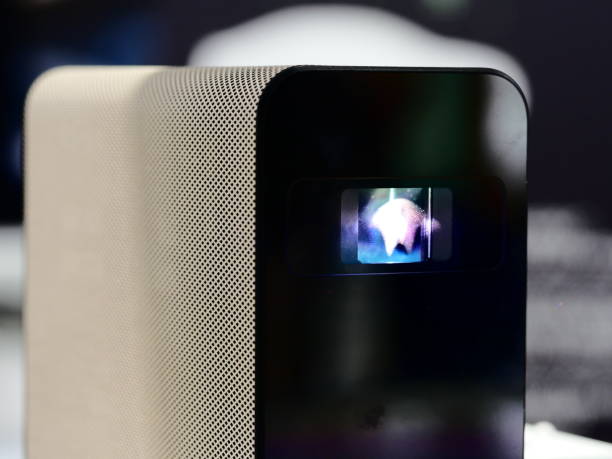After reviewing the top portable projectors, the following is what we discovered.
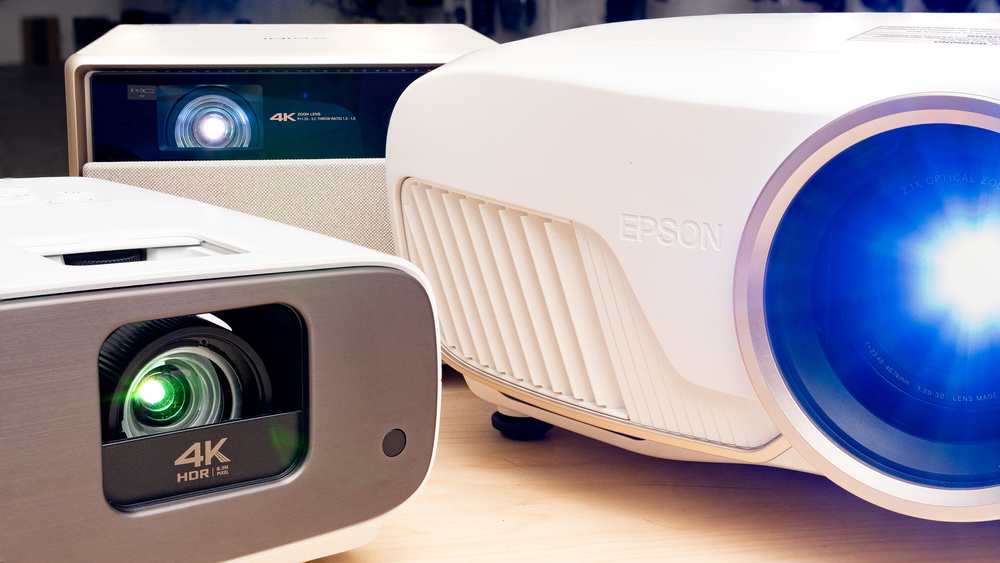
Wherever you need to, you may make presentations and view videos with the best portable projectors. Additionally, they’re a fantastic way to watch movies outside as summer approaches.
To identify the finest tiny projectors for replacing your TV or monitor and seeing a larger image, we’ve tested and evaluated the best 4K projectors as well as the best business projectors. Don’t be duped by the size. Even though some of these devices are small enough to fit in a pocket, they yet have excellent resolutions and clear, sharp images.
We tested and evaluated weight, size, and overall portability of the top portable projectors, including both high-end and low-cost tiny models for use at work and pleasure. We evaluated device support for both desktop and mobile devices, as well as connection, ranging from wired to wireless options, during our assessment process. In addition, we looked at projector brightness, resolution, clarity, and ease of setup and operation – regardless of whether your next showing takes place in the field, at home, or at the office.
Top 5 Best Portable Projector In 2024
1.Samsung The Freestyle 2nd Gen
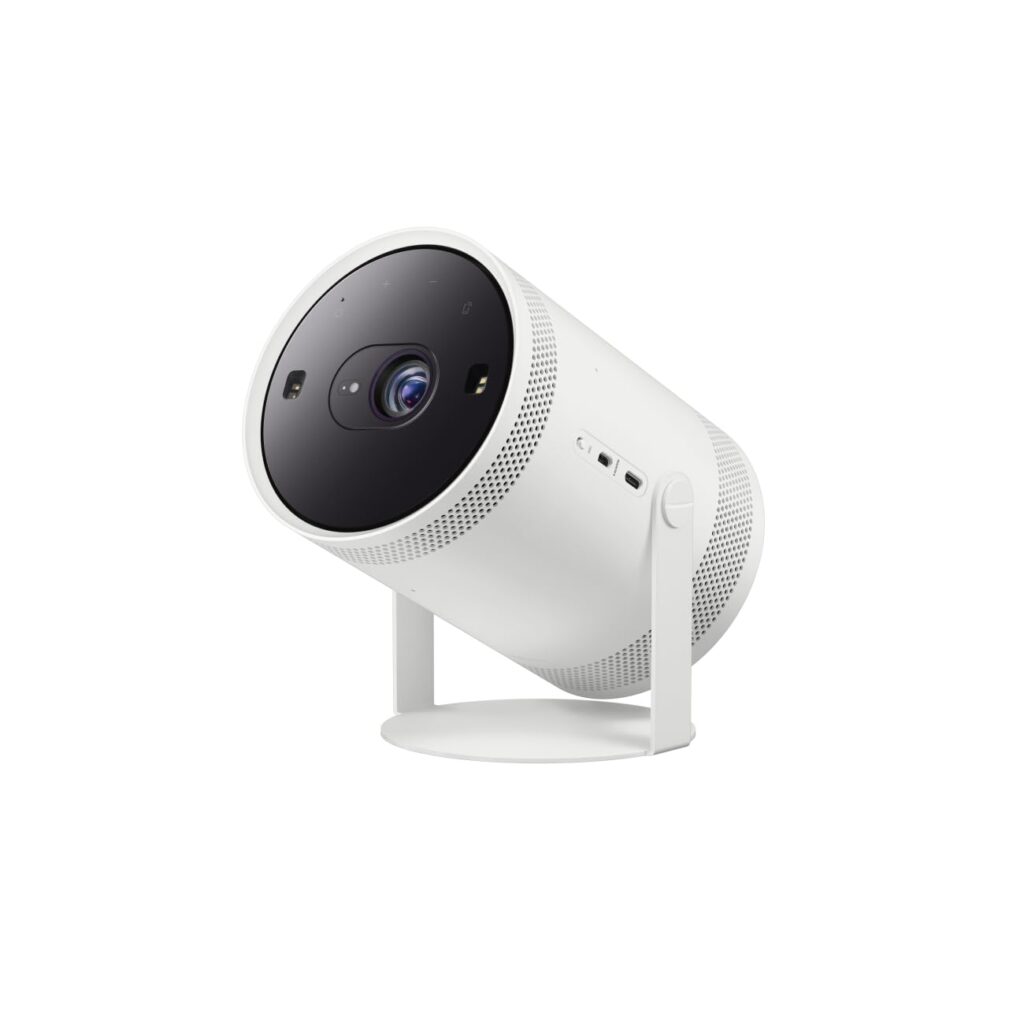
Pros
- Super-compact design
- Easy to use and navigate
- Built-in Gaming Hub
Cons
- Low brightness and contrast
- Micro-HDMI
- Expensive
We previously considered the original Samsung Freestyle tiny projector to be the best option, as we were already huge admirers of it. Up until we tested out the second-generation model, it had remained that way.
The Freestyle 2nd Generation from Samsung isn’t a major upgrade over its predecessor, but it does come with a Gaming Hub that allows you to attach a wireless controller and use cloud-based gaming apps like Xbox and Nvidia GeForce Now. A major factor in the attractiveness of The Freestyle is how simple it is to assemble, and its understated, portable form makes it perfect for carrying in a backpack.
When used, the picture quality is good, supporting HLG, HDR10, and HDR10+, with deep blacks and realistic colors. The projector also has ‘360 Degree’ sound, according to Samsung. Even though the bass was obviously restricted, we were shocked to discover throughout our testing that it actually did provide spacious music.
But we did observe a few shortcomings. This wasn’t the brightest portable projector we’ve ever tested for brightness, and it has poor contrast for outdoor daytime use. Additionally, we wish there had been more than one micro-HDMI connection (or at the very least, an HDMi converter included in the package). Although it might not be a low-cost model either, all things considered, this is a great, user-friendly little projector that places a strong emphasis on portability.
The original Freestyle model is a great substitute if you are unable to obtain the second-generation model.
2.Anker Nebula Solar Portable
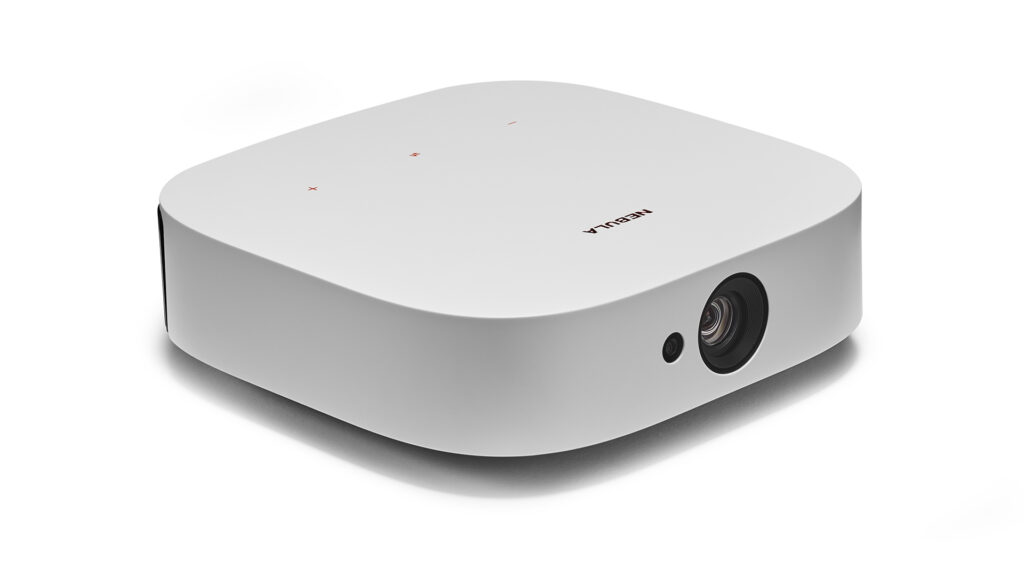
Pros
- Stunning design
- Doubles as a Bluetooth speaker
Cons
- A bit dim
- Sound could be punchier
- No wired headphone output
The Anker Nebula Solar Portable is a compact and stylish mini projector that we enjoyed testing because it delivers in almost every area at an affordable price.
It has a stylish appearance and will look fantastic stored on a living room shelf in between uses. However, at just 2.38kg and dimensions 19.2 x 19.22 x 5.45cm, it’s lightweight enough to fit into a tote bag, backpack, or drawer for portability.
We discovered that the battery lasts roughly three hours, which is respectable for a tiny, portable projector and ought to be plenty for watching a movie when you’re not near a plug outlet. Its USB-C power socket, however, should allow you to connect a portable power bank for a variety of functions.
The Solar Portable’s Bluetooth speaker capability is a fantastic addition to its feature set, combining the functions of a projector and a Bluetooth speaker into one convenient package.
We were dissatisfied with the projector’s brightness during testing, even though the picture quality is respectable considering the cost and form factor. Even in optimal viewing settings, the Nebula Solar Portable’s 400 lumen brightness will make it tough for it to stay visible in bright environments, and dark scenes will be challenging to see.
It’s a good option if you’re searching for a respectable projector. However, you’ll need to change to one of Anker’s more expensive versions, such as the Anker Nebula Cosmos Laser 4K below, if you want a bright and striking display.
3.Anker Nebula Cosmos Laser 4K
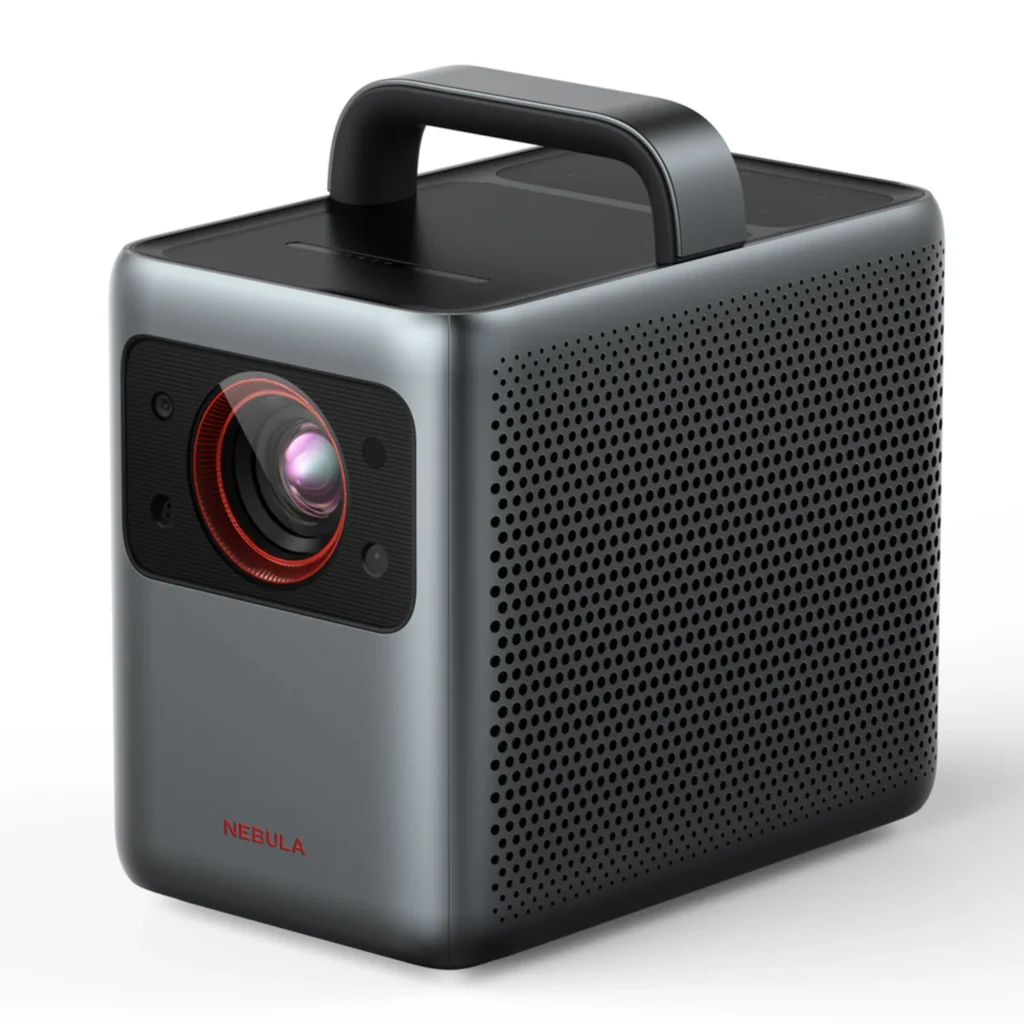
Pros
- Stunning design
- Doubles as a Bluetooth speaker
Cons
- Sound could be punchier
- No wired headphone output
This small projector is not your typical one, the Anker Nebula Cosmos Laser 4K. During our testing, we found that its peak brightness of 2,400 Lumens was adequate for a semi-controlled atmosphere. Additionally, its laser lamp produces an excellent image quality.
It looks fantastic and is more than capable of serving as your daily go-to projector in your living room. When we were reviewing it, though, we had no issue packing it up and moving it from room to room because of its form factor, which measures 26.4 x 22 x 15.5 cm and weighs 4.8 kg.
But, the lack of an on-board battery poses a significant challenge to the Cosmos Laser 4K’s portability. We stated in our review that the Anker Nebula Cosmos Laser 4K isn’t particularly portable when it doesn’t have battery power. Even though it’s portable, using it still requires AC electricity.” If you’re looking for a projector to use outside or far from home, keep that in mind. If you would rather have an on-board battery, have a look at the Anker Nebula Solar Portable shown above.
It can even power the whole entertainment system for each place you move it into, thanks to built-in speakers and an integrated streaming stick that tucks away behind a cover. For a smartphone costing $2,199, £1,740, or AU$3,055, that’s not a bad offer.
Although there are many competitors for the Anker Nebula Cosmos Laser 4K, there aren’t many that will function as effectively and as effortlessly if you want a projector that you can use inside your house instead of outside.
4.Optoma ML750e HD-ready portable projector

Pros
- Good brightness
- Versatile projector
Cons
- No Wi-Fi
- Tablet integration requires dongle
The Optoma ML750e is a powerful and adaptable projector, yet while testing, it literally fit in the palm of our hands due to its tiny size and weight of only 0.4 kg and 10.4 x 10.5 x 3.9. Because of this, it is quite portable and deserving of a spot in our list of the best portable projectors.
The ML750e is a 700 Lumen lamp that provides enough brightness to allow you to present in partially gloomy surroundings. If you also wish to use it outside in the evening, this is fantastic news.
Aside from its size and image, the Optoma ML750e’s remarkable range of ports make it one of the greatest portable projectors available. It has one HDMI input that is ready for MHL, a microSD card slot, a USB 2.0 thumbdrive slot, and a universal I/O slot.
The ML550 performed admirably on our 90-inch test screen throughout testing, peaking at a size of about 60 inches. It’s important to note that a dongle is required in order to use Wi-Fi. That is the only noteworthy disadvantage we could find.
5.Asus ZenBeam E1 Portable LED Projector
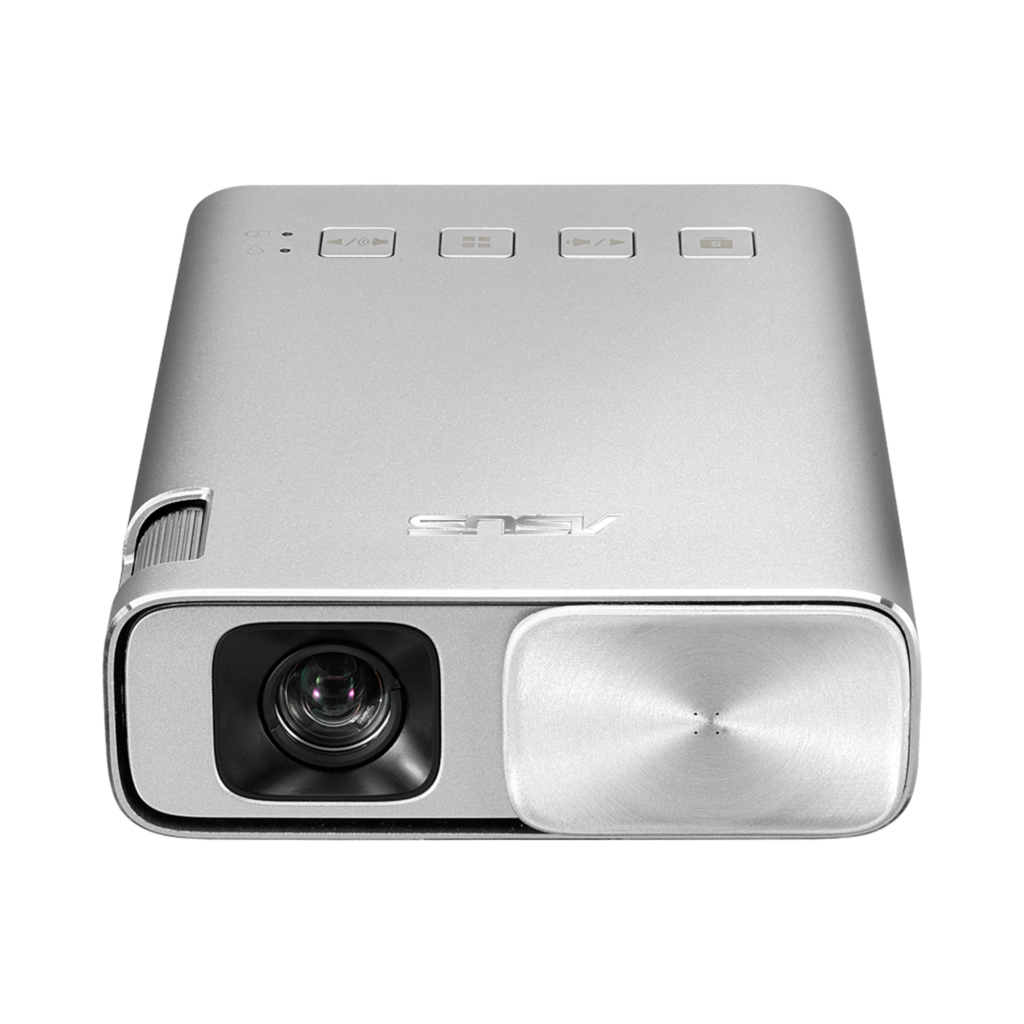
Pros
- 5-hour battery
- Very small and portable
- Can double as power bank
Cons
- Low resolution
- Low light output
An award-winning projector with exquisite design is the Asus ZenBeam E1. We adore that it weighs a just 307g and is compact enough to fit in your pocket, measuring just 8.3 x 2.9 x 11 cm.
Whether you want to view movies on your travels or need a convenient way to share presentations during meetings or business trips, its minuscule size makes it the perfect companion.
The fact that it can project images up to 120 inches in size with a respectable 150 lumen Eco-LED light source—despite its modest size—is what matters in this case.
You won’t have to worry about looking for a plug socket to power the projector long enough to get through a movie or two thanks to its built-in 6,000mAh battery, which can run the device for up to five hours.
The projector’s ability to function as a power bank for additional mobile devices is a really good feature.
Even though the Samsung The Freestyle is the most powerful portable projector in this review, the Asus ZenBeam E1 is still a great option for travelers due to its portability, simplicity of setup, and striking appearance.
Best portable projectors: FAQs
Is a projector that has more lumens better?
We questioned Bob Wudeck, BenQ’s Senior Director of Business Development.
Similar to a car’s horsepower, a projector’s lumens indicate only a portion of its overall suitability for the job. Lumens used to be the most significant component. Things have changed since the majority of projectors on the market now are significantly more sophisticated than those from five years ago. What then distinguishes a superior projector?
Color accuracy: Despite stringent guidelines for color reproduction, many projectors used in classrooms and conference rooms still lack adequate color accuracy. Rec. 709 is the standard for color accuracy and measurement to look for in the requirements for more recent home theater and commercial projectors.
Resolution: Although the majority of TVs on the market now have more than 8 million pixels, projectors with less than 1 million pixels are still available. More pixels are required for a nicely detailed image on a larger screen. For the best pixel density, search for projectors with native resolutions of either 1080p or 4K UHD.
Solid State Lighting: Projector bulbs cost a lot of money, require frequent replacement, and contain mercury. Solid state light sources, such as lasers and highly bright LEDs with a 30,000-hour lifespan, are gradually replacing them. These days, a high-brightness LED projector with 4,000 lumens and better color accuracy can be purchased for a relatively little amount more than a projector with a comparable lamp power.
Throw Ratio: The appropriate throw ratio will have a significant impact on your setup. If you’re using a golf simulator, for instance, you’ll need a “short throw” projector that can be positioned so that you may play without creating a shadow on the screen. To determine how far back your model needs to be mounted in order to fill your screen, use a projector calculator.
Can I use my little projector to stream Netflix?
We questioned Bob Wudeck, BenQ’s Senior Director of Business Development.
With a portable projector, it should be simple to launch Netflix on your phone and couple it with the device to view Netflix or other streaming apps in the large format that the projector can display. However, because to laws passed and regulations upheld by content owners, a lot of premium streaming apps, such as Netflix, Prime Video, Hulu, and Disney Plus, include copy protection that forbids mirroring from mobile devices. Therefore, if you’re casting from a notebook, you can cast Netflix material wirelessly using the Google Chrome browser on your laptop, which is wired to an HDMI port. You can stream media using Apple TV or Chromecast wireless devices as well. The greatest tiny projector models come with phone apps as well.
Is it possible to link a phone to a projector?
We questioned Bob Wudeck, BenQ’s Senior Director of Business Development.
Three simple methods exist for linking a phone to a projector:
Cable: A video output port may be found on almost all iPhones and Android smartphones. Since HDMI is still the most common input port for projectors, all you need to do to connect the cable is switch the source to begin screen mirroring from your phone to a projector. You can connect the cable with ease using an adapter from the USB-C connector on an Android device or the HDMI connector on an iPhone.
Casting: You can wirelessly connect to your projector and mirror your screen if you have an Apple TV or Chromecast. In order to send the content to your projector, you must first connect to the receiver’s network using the built-in screen mirroring feature. For occasional use or when you wish to display images or movies on your tablet, this is a good solution.
Wireless Presentation System: Compared to the other two options, a wireless presentation system is quicker and more secure for usage in business or education. The greatest models let you to quickly begin sharing content by simply plugging in a button to connect your phone or tablet. Others share the screen using Airplay or a specific app that is installed on your phone. The better devices, though more expensive, encrypt the communication, making it impossible for nearby inquisitive parties to wirelessly record and view important information.
Do portable projectors perform well?
Indeed! Consider it as the distinction between your living room speakers and a portable Bluetooth speaker. The latter can sound louder and have a better sound quality, but they are not precisely portable enough to be taken to the beach in a bag. It is a huge pain even to take them out into the garden.
With portable projectors, it is the same story. Their go-anywhere talents and extreme practicality make up for their usually – but not always – lower intelligence and power compared to their wired siblings. Because of their portability, battery-operated portable projectors can be used for movie nights without the hassle of locating a power outlet. They are also very easy to put up and move about.
That being said, they’re not limited to using them in the great outdoors. Because of their compact shape, portable projectors come in handy in spaces where a standard-sized projector is either unsuitable or impractical, as well as in households where the projector may not always be in one particular room.
Brightness is the primary trade-off for portable projectors since it consumes the most energy. As a result, battery-operated projectors must balance the brightness of their images—which influences the display’s maximum range and size—with the length of time between recharges.
What makes a projector different from a tiny projector?
A standard projector and a mini projector are primarily distinguished by their priorities. While mini projectors also deliver good quality, their designs prioritize portability and affordability, making them more affordable and portable than their larger siblings and frequently featuring built-in speakers and simple Bluetooth speaker connectivity, traditional projectors are made to produce the highest possible quality at the most significant possible size, and if that means more giant bulbs or LED assemblies and louder fans, then so be it.
While many small projectors are made to run on batteries, standard projectors are primarily powered. They have shorter running times than when they’re plugged in, much like any battery-operated gadget, but the majority of models have more than enough power to play many movies without needing to be recharged in the middle. In order to extend the battery life, it may also indicate that the projector is dimmer than a connected one.
Another significant distinction is that, in comparison to wired counterparts, small projectors may have fewer connection possibilities because of their quick setup design. Nonetheless, a lot of tiny projectors can now receive video from a variety of sources thanks to the expanding use of wireless technologies like Google Cast and AirPlay as well as intelligent TV-style features like streaming apps that operate over Wi-Fi.
How to pick your ideal portable projector
It’s critical to understand what to consider before making a portable projector purchase.
We contacted display and projector specialist Luke Chen, senior business line manager at Viewsonic Europe, for his opinion. By taking into account how you’re going to use it, you’ll obtain the correct mix of functionality.
First and foremost, you should consider the scenarios in which you plan to use your projector and select one that meets your needs. Are you traveling with your smart projector? Examine the projector’s ability to achieve a portable design. Is there a carry handle included? Or is it foldable into a container that is ready for travel? Make sure the projector is designated as a “short throw” if it will be placed on your coffee table.
When considering durability, keep in mind that LED technology prevents dimming issues with projectors, enabling smart projectors to shine brightly for up to 30,000 hours. LED light sources run much cooler than bulb-based light sources (meaning less fan noise). If a projector is labeled as “Lamp-Free,” it means that it is environmentally friendly and eliminates the need for glass bulbs, which contain mercury.
The next factor to think about is resolution. Since smart projectors are much smaller than standard projectors, resolution should come first. Lower resolutions are suitable for campers who simply want to watch something next to the campfire; mini projectors struggle with resolution. However, not all smart projectors have poor resolutions; 4K Smart LED projectors are now available; if you prefer to watch entertainment at home, go for 4K resolution. The most expensive smart projectors will be branded as “True 4K” projectors.
Apps are next in line. The apps you use on your projector determine how intelligent it is. Thus, it makes sense to have your projector’s app store activated. Does the projector you are considering have interaction with the app store? A smart projector with plenty of processors, memory, and storage will allow you to stream movies, use apps, and activate voice commands all at once.
Most intelligent projectors have to give up on audio quality. There isn’t another way to cram everything into something this tiny. Select high-quality speakers for your home theater if it does not already have a high-end sound system built in. To put it succinctly, no projector is suitable for every situation.
How we test the best portable projectors
Over the years, we have tested a wide variety of projectors, but in our quest for the finest portable projector, there were a few important factors that we needed to take into account.
The most apparent is mobility. To various people, this will signify different things. We have made it clear in the instructions above that certain designs—like the Anker Nebula Cosmos Laser 4K—are movable since they can be moved from room to room. Conversely, some are small enough to fit in a pocket, such as the ASUS ZenBeam E1 Portable LED Projector. Technically speaking, both are “portable,” but to different extent; we have clarified this in the instructions.
Projector usability is crucial. If it takes a lot of effort to set up, there’s no need bringing one around. We therefore made sure that even if you’ve never used a projector before, you could immediately become up and running when testing the finest portable projectors.
While the brightness and picture quality in our list above differ, all of them can project movies and TV shows at a respectable pace. Our primary search criteria included projectors with reasonable brightness and resolution in relation to their size and cost. We’ve explained when you’ll probably have a duller experience, but in a little, reasonably priced bundle, which may be more important to some.

